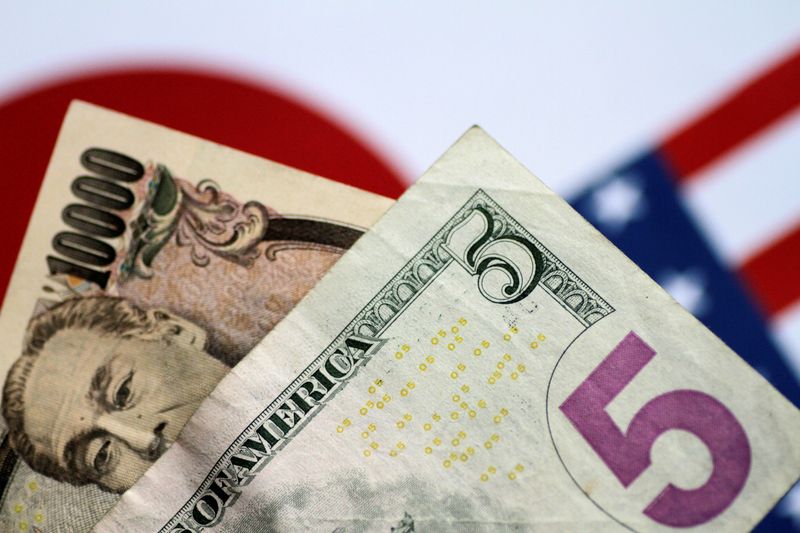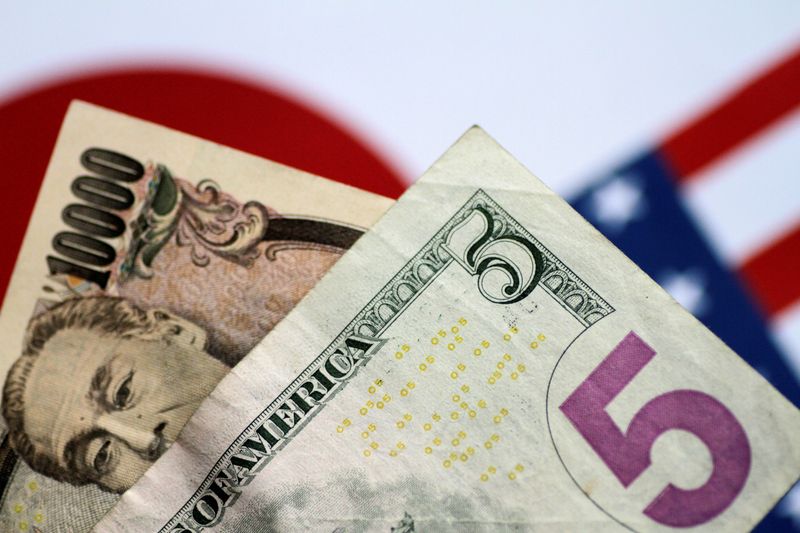
By Ankur Banerjee
SINGAPORE (Reuters) -The U.S. dollar was on the back foot on Thursday after the Federal Reserve opened the door for an interest rate cut in September, helping keep the yen pinned near its highest since March in the wake of a hawkish pivot from the Bank of Japan.
An action-packed Wednesday started with the BOJ raising Japan rates to levels not seen in 15 years, leading to traders reassessing popular carry trades before the Fed held rates steady but put rate cuts on the table as US inflation cools.
The yen was volatile in early trade, surging nearly 1% to 148.51 per dollar, its highest since mid-March before settling at 149.95.
“BOJ normalisation and Fed cut in due course represent a shift from Fed-BOJ policy divergence to convergence,” said Christopher Wong, currency strategist at OCBC.
“Policy convergence should change the direction of travel for USDJPY to the downside. The risk here is that Fed doesn’t play ball,” he said.
The BOJ also announced plans to halve its monthly Japanese government bond purchases as of January-March 2026, with Governor Kazuo Ueda not ruling out another hike this year.
The yen surged 7% in July, its strongest monthly performance since November 2022, after starting the month rooted near 38 year lows in large part due to bouts interventions by Japanese authorities that totalled $36.8 billion.
Those interventions led to an unwinding of profitable carry trades, in which traders borrow the yen at low rates to invest in dollar-priced assets for higher returns.
Still, the yen remains hamstrung by the wide interest rate difference between Japan and the United States and is down 5% against the dollar so far this year.
“The BOJ showed it will play its part and this should help stabilize the yen but much of the remaining wide yield differential would need to be closed by the Fed,” said portfolio managers from the Multi Asset team at AllianzGI.
“In absence of Fed action, JPY shorts may begin to re-emerge.”
CFTC data shows speculators’ bearish bets against the yen are 40% below April’s near-seven year high, though at a still elevated $8.61 billion.
The dollar index, which measures the U.S. currency against six peers, was at 104.03, having dropped 0.38% on Wednesday. The index fell 1.7% in July, its weakest monthly performance this year.
The euro was at $1.082875 after rising 1% in July, while sterling was steady at $1.28485 ahead of the Bank of England policy decision, where the central bank could cut rates but markets and economists remain far from certain.
DOVISH FED
With the Fed staying data dependant, investor focus will be on Friday’s government jobs report for July. It is expected to show that employers added 175,000 jobs during the month, according to economists polled by Reuters. July inflation report will be the next key data and is due to be released on Aug. 14.
Markets have been fully pricing in a 25 basis points (bps) of rate cut in September for some time and added to wagers of the Fed going big even after Fed Chair Jerome Powell said policymakers are not thinking about a 50-basis-point interest rate cut “right now”.
Traders are now anticipating 72 bps of easing this year.
“Markets have been expecting more rate cuts than what the Fed’s June dot plot showed going into yesterday’s announcement. And Chair Powell did not seem to provide any opposition to that view,” said Charu Chanana, head of currency strategy at Saxo.

“This has bolstered market expectations that bigger rate cuts remain likely, and will be heavily influenced by how the economy progresses from here.”
In other currencies, the Australian dollar was 0.11% lower at $0.6529 after sliding 2% in July, while the New Zealand dollar last fetched $0.5951.
This post is originally published on INVESTING.




